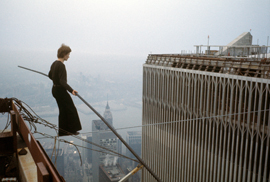Oscar-winning “Man on Wire” Epitomizes Storytelling Vogue
Sunday’s Oscar pick for Best Documentary Feature was surprising in that it eschewed the usual social issue film that generally wins big awards. However, I was thrilled when Megan Mylan, a graduate of our documentary program at UC Berkeley, won Best Short for her social issue drama Smile Pinki. At Cal, we teach our documentary students that there are several time-honored ways of structuring documentaries. Man on Wire, which might have won top honors on its classy reenactments and lush archival footage alone, epitomizes the kind of character-quest films that have dominated the documentary scene for more than a decade.
Here is a young Frenchman who sets his sites on an impossible (and illegal) feat: to traverse a tightrope stretched between the two tallest buildings in the world. Can you imagine a more awe-inspiring, superhuman quest? Note that the charismatic central character, Philippe Petit, has a tangible goal. In screenwriting parlance, his “object of desire” is concrete (in fact, the “wire” is literally moored in concrete). The lesson for directors seeking a good character-driven story is to ask yourself this question: Is my character’s goal corporeal or measurable? An ephemeral quest such as “finding oneself”, promoting racial harmony or bridging the class divide should, ideally, be embodied in something so specific that you could hold it in your hands or capture it in a snapshot. Click. Man teeters on wire between the World Trade Center’s twin towers.
Man on Wire illuminates two other important features of character-driven films. First, Act One doesn’t skimp on an inciting incident, using a well-shot reenactment to launch the story, while Philippe Petit recalls sitting in the dentist office nursing a toothache at age seventeen. Flipping through magazines, he sees an illustration of the yet-to-be-built twin towers. Philippe gasps and is seized by a desire to walk “the wire” between the highest edifices man can erect. His visualization is so strong that he covertly rips out the article, ignores his toothache, and races home to fuel his imagination and begin plotting.
Many screenwriters begin plotting their story with just two points: the inciting incident that kicks off the quest and the climax that realizes it. Like screenwriters, filmmakers of historical docs have the advantage of hindsight, and the climax of Man on Wire was destined to be a spectacular success. It not only dovetails the film’s parallel timelines, but it satisfies the three requisites of any stellar story climax:
1) The scene calls forth the protagonist’s deepest reserves (recall the dizzying handheld shot lurching over the tower precipice and you get the picture);
2) it evokes the audience’s deepest emotional response (gasp, laughter, tears, etc.)
3) it answers unequivocally the film’s central question-does the protagonist get what they want or not?
I won’t spoil the ending, in case you haven’t seen Man on Wire. But if you’re interested in how to structure a good character-driven film, see this 2009 Academy Award-winning doc soon. And if you’ve already seen it, consider watching it again, to deconstruct the anatomy of the trendiest genre in town.
FYI, I will be teaching my weekend seminar, “Structuring the Character-Driven Documentary”, at the San Francisco Film Society on April 18 and 19th. Last Fall this class sold out. For more information, visit: http://www.sffs.org/filmmaker_services/schedule.html#10
